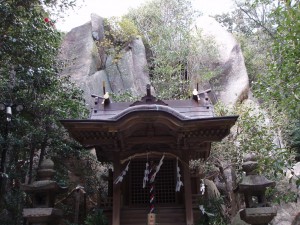All hail to Emperor Kammu! When he founded Heian-kyo (Kyoto) in 794, he took note of the surrounding hills. ‘The mountains and rivers are the collar and belt of this area, and make … Read the rest
All hail to Emperor Kammu! When he founded Heian-kyo (Kyoto) in 794, he took note of the surrounding hills. ‘The mountains and rivers are the collar and belt of this area, and make … Read the rest
Kibune Jinja is small but special; in Heian times it was designated one of the top 22 shrines. It’s noted for being dedicated to a water kami and is located just above the river. There is water gushing all around … Read the rest
A Mighty Megalith
Small but potent is how you might describe Koshikiiwa Jinja. It’s not one of Kansai’s famous shrines. Located on a hill at Korakuen, it’s an appendage to the grander Nishinomiya Shrine and enshrines the same deity: hence … Read the rest
 Amy Chavez has written an article in the Japan Times on the sacred rocks of the island where she lives in the Inland Sea.
Amy Chavez has written an article in the Japan Times on the sacred rocks of the island where she lives in the Inland Sea.
http://search.japantimes.co.jp/cgi-bin/fl20110709cz.html
I’m a big fan of the island, and particularly of the rocks there… they come … Read the rest
To anyone living in Japan the phenomenon of iwakura and kami-inhabited rocks is very striking. I would even suggest that it’s central to Shinto. So I find the omission of discussion about iwakura in English-language material to be puzzling and … Read the rest
© 2025 Green Shinto
Theme by Anders Norén — Up ↑